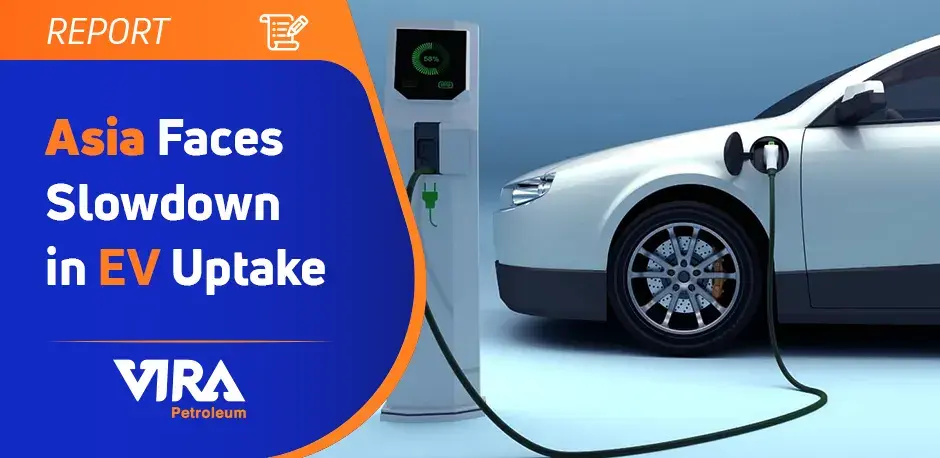During a recent presentation at the ICIS Asian Base Oils and Lubricants Conference held in Singapore, industry expert Eugene Tan discussed how the impact of electric vehicles on the lubricants industry will vary in Asia compared to Europe and North America.
Tan explained that Asia faces several challenges that impede the electrification of its vehicle parc, which will ultimately impact the demand for lubricants in the region. While many developed countries in Europe and North America have already announced their zero-emissions goals, their mandates primarily focus on the transition to plug-in electric vehicles, rather than hybrids.
Order : recycle base oil
This means that the internal combustion part of the vehicle is expected to disappear in these regions. Consequently, many Western car companies have stopped research and development on the next generation of internal combustion engines and are instead focusing on electric vehicles. However, in Asia, car manufacturers such as Tata in India are still looking at producing new vehicle models that run on internal combustion engines, indicating a slower transition towards electric vehicles in this region.
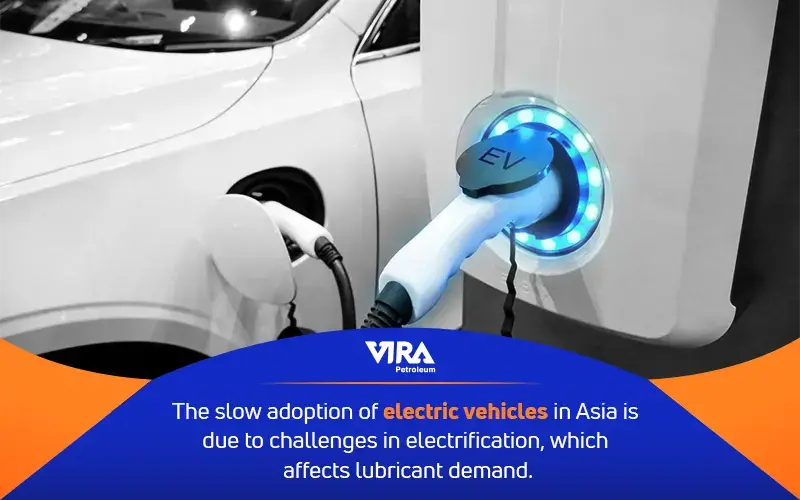
According to Eugene Tan, the Chief Executive of the Asian Lubricants Industry Association, twelve countries in Western Europe and North America have already committed to phasing out the sales and registration of internal combustion engines (ICE) over the next ten years.
However, this move towards electrification is not as widespread in Southeast Asia, with only Singapore making a similar commitment, while Japan and Australia have their own mandates. In contrast, China is aiming to have 40% of new vehicle registrations be battery electric vehicles by 2030, and some Asian countries are offering incentives to encourage the use of EVs. Globally, the number of battery electric vehicles is set to increase dramatically from 8 million in 2020 to 250 million by 2030. The plan is to phase out ICE and hybrid vehicles between 2030 and 2040, at least for countries that are members of the European Union and the Organisation for Economic Co-operation and Development.
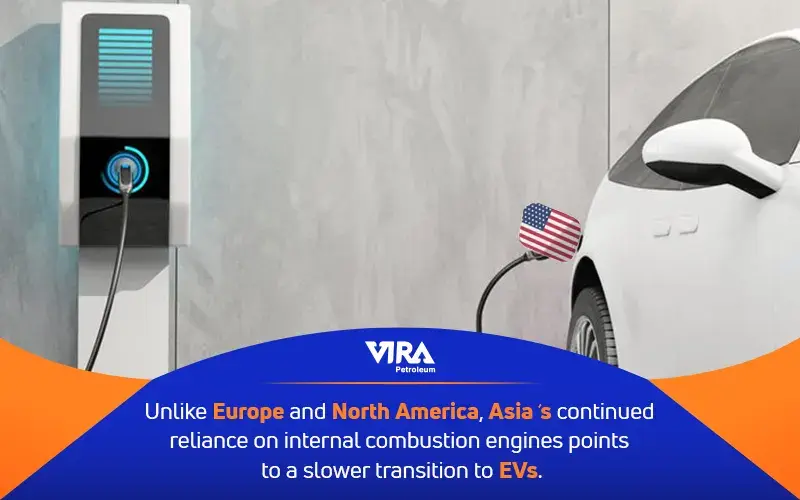
The lubricants industry is set to face significant changes as the world transitions towards electric vehicles, with automotive ICE lubricants accounting for the majority of lubricants demand, according to industry expert Eugene Tan, who is also the chief executive of the Asian Lubricants Industry Association. BEV lubricant demand, on the other hand, is expected to be far lower, mainly comprising thermal fluids, transmission fluids, and greases. As a result, countries and regions switching from ICE to BEV can expect to see a rapid decline in automotive lubricant demand from now until 2030-2035 when most of the mandates go into effect.
While the rest of the world is set to experience a dramatic increase in automotive electrification, the Asia Pacific region faces unique challenges, including a lack of infrastructure and reliable electricity supply in many Southeast Asian nations, which could impede the transition towards BEVs. Despite the fact that some countries in the region, such as Singapore, have committed to phasing out ICE engines, the lack of mandates in most Southeast Asian countries could hinder the electrification of their vehicle parc.
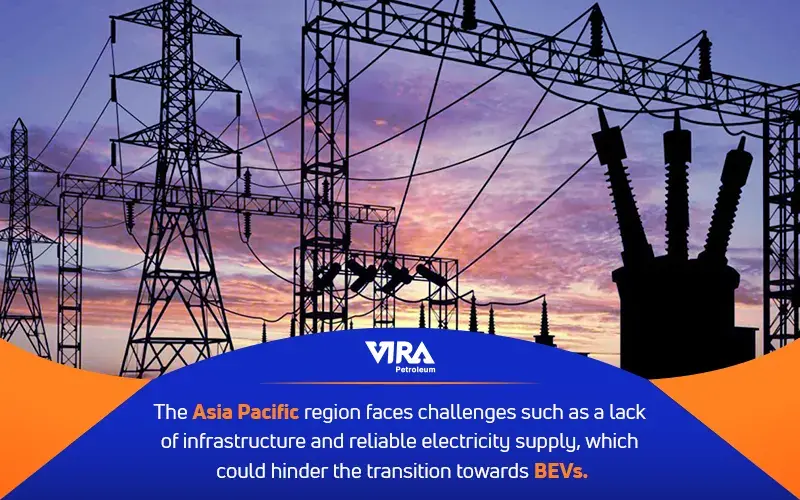
During a presentation at the ICIS Asian Base Oils and Lubricants Conference, Eugene Tan, Managing Director of Emvolution and CEO of the Asian Lubricants Industry Association, pointed out that the electrification of mobility will have varying impacts on different regions due to the specific challenges they face. While many developed countries have already committed to phasing out ICE engines, the Asia Pacific region faces a number of obstacles that could impede the transition to BEVs.
related topic : Rising Lube Additive Demand Predicted
One of the biggest challenges in many Southeast Asian nations is the lack of infrastructure and reliable electricity supply, as around 65 million people in ASEAN countries do not have access to stable electricity, and in India, 660 million rely on biomass for cooking fuel. Governments in the region will likely prioritize investing in electric supply infrastructure and grid upgrades to supply power for basic needs such as refrigeration and cooking, rather than electric vehicles for the wealthier population. Thus, BEV adoption will likely be slower in Asia Pacific.
Tan highlighted that governments in OECD/EU countries provide incentives of $7,000-15,000 to encourage BEV adoption. However, if ASEAN/India governments were to use $10,000 incentives to move just 20% of existing vehicles to electric by 2030, the cost would be approximately $1 trillion, a figure beyond their financial means. Additionally, the variety of vehicles on the road in many Asian countries suggests that the speed of electrification will vary for different classes of vehicles such as trucks, cars, and motorcycles. Tan expects that motorbikes and public transportation in main cities will see faster adoption of EVs than trucks used for cross-country transportation.
Tan highlighted the faster adoption of electric PMDs in Asia, as their batteries serve a dual purpose of powering not only the vehicles but also other household needs. In fact, these electric PMDs help address the power supply gap in rural areas, where access to stable electricity is limited. By swapping their batteries at stations, consumers can power their homes at night and use the remaining charge for their transportation needs the following day
However, the challenges of powering EVs in Asia are significant, especially considering that many countries rely heavily on coal for electricity generation. China, for example, produces 65% of its electricity from coal, and a staggering 80% of new coal power plants under construction are located in Asia. In light of this, there is a growing concern over whether the electrification of mobility in these regions actually reduces CO2 emissions, or whether it simply encourages the construction of more coal power plants to support EVs.
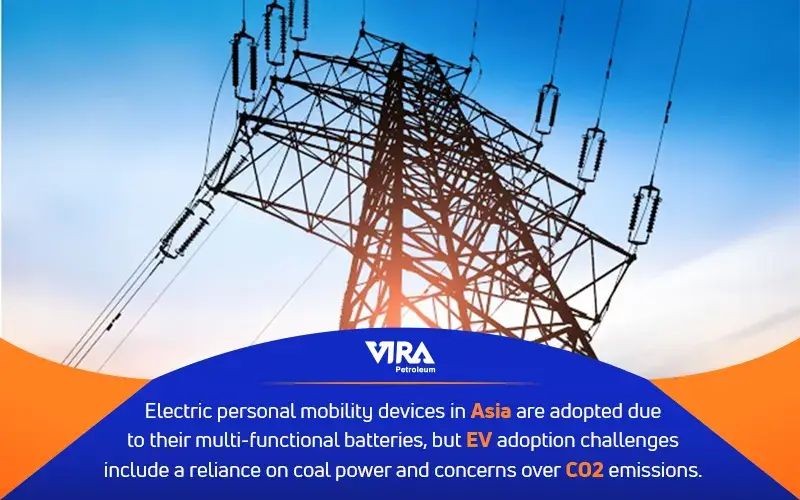
According to Tan, the shift towards electric vehicles in the West will lead to a decline in lubricant demand, while lubricant consumption in Asia is expected to increase to match China’s growth over the last ten years. This trend could create opportunities for base oil and lubricant manufacturers in the region. While global demand for lubricants is projected to remain steady, the shift from West to East will result in Asia representing a significant portion of new ICE vehicle registrations, as ICE and hybrid vehicle sales may be prohibited in EU/OECD countries by 2040.
Tan highlighted the growing middle class in Southeast Asia as a key driver for the rise of personal mobility in the region. As the GDP of many Southeast Asian nations continues to increase rapidly, more people will have access to cars. In fact, the uptake of cars increases exponentially when a country’s GDP reaches $5,000 per capita, and countries like India, Indonesia, Vietnam, and the Philippines are expected to reach this point by 2030. Despite this expected increase in automotive demand, vehicle density in Asia is still relatively low compared to Europe and the U.S., with less than 100 vehicles per 1,000 inhabitants. In contrast, the U.S. has around 800 vehicles per 1,000 inhabitants and the EU has around 600.
Tan expressed his optimism that the emerging trends in Asia’s lubricant industry will create a plethora of opportunities for base oil and lubricant companies. However, he acknowledged that different companies may have varying perspectives on the challenges and investment opportunities presented by the industry’s changing landscape. Factors such as accountability to NGOs, shareholder pressure, pricing, and proximity may influence the approach taken by multinationals, national oil companies, or international independents.
In Asia, many OEMs will likely continue their research and development efforts for the next generation of ICEs, while in the West, OEMs have shifted their focus away from ICEs. Tan emphasized that this creates numerous opportunities, but also a range of questions and challenges that paint an interesting picture for the industry in the coming decade. For instance, he pondered who will maintain relationships with Asian OEMs and meet their needs in terms of lubricants and additives.
source:www.lubesngreases.com
